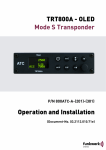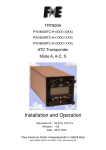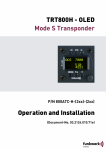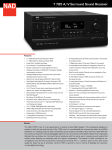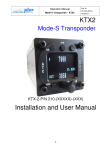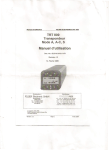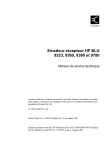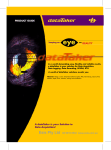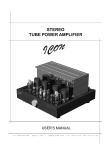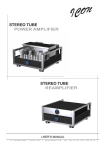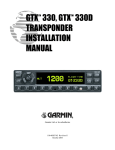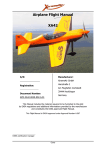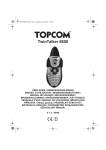Download TRT800 Installation
Transcript
TRT800 ATC Transponder Mode A, A-C, S P/N 800 ATC-(1XX)-(1XX) Installation Manual Document No.: 03.2101.010.12e Revision 1.10 Datum: 18.05.2006 Filser Electronic GmbH Gewerbestraße 2 86875 Waal phone: 08246 / 96 99-0 fax: 08246 / 10 49 web: www.filser.de Installation Manual TRT800 Doc.-Nr: 03.2101.010.12e Filser Electronic GmbH Revision: 1.10 Page: 2 of 27 Installation Manual TRT800 Doc.-Nr: 03.2101.010.12e Filser Electronic GmbH Record of Revisions Revision Date Affected Page(s) 05.04.06 all 18.05.06 all Description of Change 1.0 1.10 initial issue Para. 3.7, Plumbing installation, added Record of Service Bulletins ON RECEIPT OF SERVICE BULLETINS, INSERT SERVICE BULLETINS IN THE MANUAL, AND ENTER DATE INSERTED AND INITIALS. SB Number Revision: 1.10 REV No. Date Page: 3 of 27 Insertion Date Inserted by Installation Manual TRT800 Doc.-Nr: 03.2101.010.12e Filser Electronic GmbH Table of Contents: 1. GENERAL INFORMATION ...............................................................5 1.1. EQUIPMENT DESCRIPTION .....................................................6 2. TECHNICAL CHARACTERISTICS ...................................................7 3. EQUIPMENT INSTALLATION ..........................................................9 3.1. UNPACKING AND INSPECTING EQUIPMENT .........................9 3.2. COOLING REQUIREMENTS FOR PANEL MOUNT...................9 3.3. MUTUAL SUPPRESSION PULSES ...........................................9 3.4. MOUNTING INSTALLATION .................................................... 10 3.5. ELECTRICAL CONNECTIONS................................................. 10 3.6. ANTENNA INSTALLATION ...................................................... 10 3.6.1. Location Considerations...................................................... 11 3.6.2. Blade antenna TRT-ANT-A ................................................. 11 3.6.3. Antenna Cable Installation .................................................. 12 3.7. PLUMBING INSTALLATION..................................................... 13 3.8. AIRCRAFT Address Programming............................................ 14 3.8.1. ICAO 24 Bit Aircraft Address............................................... 14 3.8.2. ICAO 24 Bit Aircraft Address Entry Page ............................ 15 3.8.3. Guidance for Entering the Flight Identification..................... 17 3.8.4. Squitter Mode Entry Page ................................................... 18 3.9. TEST MODE Page.................................................................... 20 3.9.1. List of Error Codes .............................................................. 20 4. AIRCRAFT INTERFACE................................................................. 21 4.1. General ..................................................................................... 21 4.2. COMM-A................................................................................... 21 4.3. COMM-B................................................................................... 22 4.3.1. Close out for COMM-B........................................................ 22 4.4. Compact Position Reporting (CPR)........................................... 23 5. POST INSTALLATION CHECKOUT ............................................... 23 6. Interconnect diagrams..................................................................... 24 7. Dimensions of the TRT800.............................................................. 26 Revision: 1.10 Page: 4 of 27 Installation Manual TRT800 Doc.-Nr: 03.2101.010.12e Filser Electronic GmbH 1. GENERAL INFORMATION Mode S has several advantages over the current ATCRBS (Mode A/C) transponder standard. It offers much more efficient utilization of the existing SSR spectrum. As airspace densities continue to increase, the ability for ground stations (and TCAS) to accomplish their required surveillance of the airspace is being threatened due to saturation of the SSR spectrum. This manual describes the physical, mechanical, and electrical characteristics and the installation requirements for the TRT800 Mode S Transponder. It contains suggestions and factors to consider installing the TRT800. Close adherence to these suggestions will assure more satisfactory performance from the equipment. Information relative to operating procedures are found in the TRT800 Operation Manual (Document Number 03.2101.010.11). Safety symbols: This manual uses the following symbols to point out specific information: Warning Identifies an instruction which, if not followed, may cause serious injury including the possibility of death. Caution Denotes an instruction which, if not followed, may severely damage the equipment or other component. Note Indicates supplementary information which may be needed to fully complete or understand an instruction. Revision: 1.10 Page: 5 of 27 Installation Manual TRT800 Doc.-Nr: 03.2101.010.12e Filser Electronic GmbH 1.1. EQUIPMENT DESCRIPTION The TRT800 is a panel mounted Non-Diversity Mode S Transponder and employs one antenna, to be mounted on the bottom of the aircraft. The design meets EUROCAE ED-73B, ICAO Annex10 Amendment 77, CS-ETSO-2C112a, EUROCAE ED-73B as well as AIC IFR 6/03, AIC IFR 7/03 and AIC VFR 9/03 from the DFS and is certified to these specifications. The TRT800 transponder is a radio transmitter and receiver that operates on radar frequencies, receiving ground radar interrogations at 1030 MHz and transmitting a coded response of pulses to ground-based radar on a frequency of 1090 MHz. The TRT800 is equipped with IDENT capability that activates the Special Position Identification (SPI) pulse for 18 seconds. The TRT800 replies to ATCRBS Mode A, Mode C and required formats for Mode S interrogation. It also transmits the acquisition and extended SQUITTER depending on pre-selection and provided aircraft data. Mode A replies consist of any one of 4,096 codes, which differ in the position and number of pulses transmitted. Mode C replies include framing pulses and encoded altitude. Mode S interrogations are selective. The Mode S transponders can respond to a single directed interrogation from the ground station or another aircraft. The TRT800 is a Level 2es Class 2 transponder, providing downlink of aircraft information. Ground stations can interrogate Mode S Transponders individually using a ICAO 24-bit Mode S address, which is unique to the particular aircraft. In addition, ground stations may interrogate a TRT800 for its Transponder data capability and the aircraft's Flight ID, which may be the registration number or other call sign. In addition to displaying the code, reply symbol and mode of operation, the TRT800 screen displays pressure altitude, depending on equipment configuration selection. The unit also features a temperature compensated high precision piezoresistive pressure sensor and a RS232 I/O data port. Revision: 1.10 Page: 6 of 27 Installation Manual TRT800 Doc.-Nr: 03.2101.010.12e Filser Electronic GmbH 2. TECHNICAL CHARACTERISTICS Compliance: CS-ETSO-2C112a Physical Dimensions: TRT800 Height: 2,6 in 6,6 cm Width: Length: Weight: 2,6 in 6,6 cm 7,1 in 18 cm 1,5 Ibs 0,7kg Applicable Documents ICAO Annex 10 Amendment 77,CS-ETSO-2C112a, TSO-C112 EUROCAE ED-73B, EUROCAE ED-26, RTCA DO-160D, RTCA DO-178B, AIC IFR 6/03, AIC IFR 7/03, AIC VFR 9/03 Mounting TRT800: Operating Temperature Range: Altitude Range Panel 57mm -20 °C to +55 °C short-time +70°C 15,000 ft Cooling: Vibration: Shock: Power Input TRT800: No forced-air cooling required, but recommended. DO160D, Cat. S, Vibration Curve M Rigid mounting 6 G operational, 20 G crash safety. Receiver Characteristics: Sensitivity The minimum triggering level (MTL) is defined as the minimum input power level that results in a 90% reply ratio if the interrogation has nominal pulse characteristics. A. The MTL for ATCRBS and ATCRBS/Mode S AllCall interrogations will be -74 dBm ±3 dB. B. The MTL for Mode S interrogations will be 74dBm ± 3 dB. Revision: 1.10 between 10 and 16 Vdc typical: 0.40 A @ 13.8 Vdc maximal: 0.7A @ 13.8 Vdc 10 Watts (max) Page: 7 of 27 Installation Manual TRT800 Doc.-Nr: 03.2101.010.12e Filser Electronic GmbH Transmitter Characteristics: Reply Transmission Frequency: RF Peak Power Output: Squitter: 1090 ± 1 MHz. at least 18,5dBW (71 watts) peak power minimum at the terminals of the transponder antenna. Random intervals uniformly distributed over the range from 0.8 thru 1.2 seconds, full self verification of data and occurrence Mode S Elementary Surveillance 24-bit aircraft address Mode S Address unique to each aircraft as assigned by appropriate state authorities Automatic reporting of aircraft identity Capability Report Flight ID: Flight Plan call sign or aircraft registration marking Reports the available data and means by which the transponder can report. Pressure Altitude Up to 15.000 ft in 100 ft increments Flight Status Airborne / on-ground Mode S Enhanced Surveillance Level 2 (es) Revision: 1.10 Comm A / Comm B 56/112 Bit Messages Page: 8 of 27 Installation Manual TRT800 Doc.-Nr: 03.2101.010.12e Filser Electronic GmbH 3. EQUIPMENT INSTALLATION The TRT800 installation will conform to standards designated by the customer, installing agency, and existing conditions as to the unit location and type of installation. However, the following suggestions should be considered before installing the TRT800. The installing agency will supply and fabricate all external cables. Interconnect diagrams are included at the end of this manual. Transponder, AC Address Adapter, all cable and antennae should be installed as per FAA Advisory Circular AC43.13-2A Methods and Guidelines and the appropriate manufacturers instructions. 3.1. UNPACKING AND INSPECTING EQUIPMENT Unpack the equipment carefully and inspect each item for evidence of damage incurred during shipment. If a damage claim has to be filed, save the shipping container and all packing materials to substantiate your claim. The claim should be filed with the transportation company as soon as possible. The shipping container and packing material should be saved in any case in the event that storage or reshipment of the equipment is necessary. 3.2. COOLING REQUIREMENTS FOR PANEL MOUNT The most important contribution to improved reliability of avionics equipment is to limit the maximum operating temperature of each unit. While modern designs consume less total energy, the heat dissipated per unit volume (Watts/cubic inch) remains much the same due to contemporary high density packaging techniques. While each individual unit may or may not require forced air cooling, the combined heat generated by several units operating in a typical panel or rack can significantly degrade the reliability of the equipment if provisions for adequate cooling are not incorporated in the initial installation. 3.3. MUTUAL SUPPRESSION PULSES Other equipment on board the aircraft may transmit in the same frequency band as the transponder, such as DME or another interfering units. Mutual suppression is a synchronous pulse that is sent to the other equipment to suppress transmission of a competing transmitter for the duration of the pulse train transmission. The transponder transmission may be suppressed by an external source and other equipment on board may be suppressed by the transponder. This feature is designed to limit mutual interference. Revision: 1.10 Page: 9 of 27 Installation Manual TRT800 Doc.-Nr: 03.2101.010.12e Filser Electronic GmbH 3.4. MOUNTING INSTALLATION A. The TRT800 is mounted rigidly in the aircraft panel. Select a position in the panel that is not too close to any high external heat source. Remember to allow adequate space for installation of cables and connectors. Avoid sharp bends and placing the cables too near the aircraft control cables. B. Standard 57mm cut-out is required for panel mounting the TRT800. C. It is fastened by four 6mm special cavity screws leading through the 4 axis of the rotating knobs. Before installation the knops and the cavity screws have to be removed. 3.5. ELECTRICAL CONNECTIONS All electrical connections, except for the antenna, are made through a single, 15 pin D-sub miniature connector. Use only the AC Address Adapter EM800 as it contains the EEPROM with the memorized ICAO Aircraft code. The AC Address Adapters EM800 listed below are available: Filser P/N TRT800EM Filser P/N TRT800EMSS AC Address Adapter EM800 with power cable. This is the standard connector supplied with each unit. AC Address Adapter EM800 with power cable and interface connector The TRT800 has to be protected by an external slow blow fuse of 2 Ampere. 3.6. ANTENNA INSTALLATION Particular attention must be paid to the proper antenna installation on the aircraft so that the specified minimum radiation is ensured. The radiation pattern needs to be verified per aircraft type. Credit can be taken from the approval of a similar type. Normally the antenna will be mounted at the bottom of the aircraft. However sufficient field strength should also be available above the light aviation vehicle so that proper detection by ACAS equipped other aircraft is ensured. The electrical interference between the antenna and any other antenna/equipment must be taken into account in such a way that no reduction of the performance of any other system will occur. Particular care should be taken to ensure that the interference on the TRT800 antenna subsystem caused by static electricity is minimized. Revision: 1.10 Page: 10 of 27 Installation Manual TRT800 Doc.-Nr: 03.2101.010.12e Filser Electronic GmbH Electrical connections to antenna shall be protected to avoid loss of efficiency as a result of the presence of liquids or moisture. All antenna feeders shall be installed so as to ensure that a minimum of radio frequency energy is radiated inside the aircraft. Especially RF hazard exposure to persons on board the aircraft should be minimized by appropriate precautions. The antenna type chosen shall be compatible with the vehicle on which it is used and the location where it is mounted. Warning Radiation Hazards In order to avoid the possibility of human body damage (e.g. to eyes) and/or ignition of combustible materials by radiated energy, a safe distance to the installed antenna must be ensured by adequate installation provisions. • • • • 3.6.1. Location Considerations The antenna should be mounted on the underside of the aircraft and in a vertical position when the aircraft is in level flight Avoid mounting the antenna within three feet of the ADF sense antenna or any other communication antenna and six feet from the DME antenna. If the antenna is being installed on a composite aircraft, ground planes must be added or a symmetrical Antenna can be installed. the antenna should be installed according to the antenna manufacturer’s instructions. 3.6.2. Blade antenna TRT-ANT-A The blade antenna is a normal ground plane antenna for installation in metal aircrafts or where a ground plane (metal plate, min. size 30x30 cm) can be installed. Other antenna will be offered by Filser Electronic GmbH when they are available. For mounting on aircraft made of composites the ground plane should be as large as possible but not less than 30 x 30 cm for satisfactory performance. If in doubt please contact the aircraft manufacturer. Revision: 1.10 Page: 11 of 27 Installation Manual TRT800 Doc.-Nr: 03.2101.010.12e Filser Electronic GmbH 3.6.3. Antenna Cable Installation When routing antenna cables, observe the following precautions: • All cable routing should be kept as short as possible and as direct as possible. • Avoid sharp bends. • Avoid routing cables near power sources (e.g., 400 Hz generators, trim motors, etc.), ignition coil or near power for fluorescent lighting. • Avoid routing cable near ADF antenna cable (allow at least a 12inch separation). A special cable type (CELLFOIL, or AIRCELL) has low attenuation at 1090 MHz but it is not very resistant against mechanical stress like sharp bends. Therefore at mounting positions in rudders it requires a careful design. Revision: 1.10 Page: 12 of 27 Installation Manual TRT800 Doc.-Nr: 03.2101.010.12e Filser Electronic GmbH The following table lists examples of the recommended antenna cable and the type of cable to be used for specific lengths of cable. Any cable meeting specifications is acceptable for the installation. FILSER PART NUMBER P/N TRT800EM P/N TRT800EMSS Install kit 1 optional P/N TRKABEL2 Install kit 2 optional P/N TRKABEL3 Install kit 3 optional P/N TRKABEL4 Antenna kit 1 optional P/N CI-105 DESCRIPTION AC Address Adapter EM800 with power cable.This is the standard connector supplied with each unit. AC Address Adapter EM800 with power cable and interface connector Cable, Coax TNC 2,5 m, 8,2ft, 0,4dB loss Cable, Coax TNC 4,0 m, 13,2ft, 0,62dB loss Cable, Coax TNC 6,5 m, 21,3ft, 1,0dB loss Transponder/ DME antenna TSO C66b,C74c CI105 Comant Industries Inc., height 3.25”, weight 0.2 lb Caution The maximum coaxial cable attenuation between Transponder and Antenna at 1090 MHz must not exceed 1.5 dB. 3.7. PLUMBING INSTALLATION Install an approved soft tubing fitting the 5mm static port at the back side of the transponder. When all connections are made, secure plumbing with appropriate clamps. Revision: 1.10 Page: 13 of 27 Installation Manual TRT800 Doc.-Nr: 03.2101.010.12e Filser Electronic GmbH 3.8. AIRCRAFT Address Programming 3.8.1. ICAO 24 Bit Aircraft Address All Mode S transponders are identified with their unique, 24 bit, ICAO Mode S Aircraft Address. This address is assigned to each aircraft operating a Mode S transponder by the governing regulatory agency. Furthermore the Mode S transponder has the capability to store a Flight Identification( FID, in most countries the tail number of the aircraft). A Mode S transponder shall include means to ensure that it is using the ICAO 24 bit aircraft address allocated to the airframe on which it is installed in all applicable Mode S transactions. The ICAO 24 bit aircraft address must be correct at all times, as it is used for the technical addressing of the aircraft. Any duplication of an address in a particular airspace would put the data surveillance and integrity figures of Mode S in jeopardy. Note Any intervention of the user may accidentally result in a wrong ICAO 24 bit address and may therefore cause serious technical problems in ACAS or ATC systems. The transponder must include means to input and store the aircraft address (AA) and the flight identification (FID). To meet this specifications the TRT800 has an external memory (EEPROM) inside the connector housing of the cable set, which will be delivered with the unit. This cable with memory will remain installed in the aircraft after the unit is removed to insure that the ICAO 24 bit aircraft address is fixed to the aircraft. Revision: 1.10 Page: 14 of 27 Installation Manual TRT800 Doc.-Nr: 03.2101.010.12e Filser Electronic GmbH 3.8.2. ICAO 24 Bit Aircraft Address Entry Page When the unit is turned on for the first time, or an invalid address is recognized, the unit will prompt the user to enter a valid aircraft address (ID). Without entering an ID the Transponder will not have any Mode S functions but will still be in Mode A/C operative. Note Only approved maintenance shop have the personal and equipment to insure that the programming of the aircraft address/category/squitter and the installation are performed and tested properly. A. Case of no valid ICAO 24 Bit Aircraft Address in memory (factory setting) 1. Switch the unit to “ON” condition. The display will show “CRADLE OFF-- OUT OF ORDER” Press and hold the “FID” button and a number on the right top side of the display starts counting up 1, 2, 3… Release the button at 47. 2. On the display the lower line shows a long number as described in the picture below. The first 6 digits are the aircraft address (ICAO 24 bit AA in HEX-format, received from your local aviation authority) followed by 2 digits for the aircraft category (e.g. 19 for gliders) and then 7 digits for the Flight Identification (FID). Caution The ICAO Flight Plan specifies only 7 characters as Flight Identification. Filser reserves 8 characters as stated in ED73B for further expansion of the flight plan. The user shall only program 7 characters for FID. Please refer to chapter 3.6.3 for guiding instructions. Revision: 1.10 Page: 15 of 27 Installation Manual TRT800 Doc.-Nr: 03.2101.010.12e Filser Electronic GmbH 3. Insert the valid ICAO aircraft address in HEX format, the aircraft category and the Flight Identification ( which is usually the aircrafts tail-sign, see chapter 3.6.3) by using • the lower right rotating knob (..X. ) as a cursor “^” position • the lower left knob (.X..) to change the contents of the selected position (0-9 and A-F). 4. Confirm the entered code by pressing the “MODE” button. 5. The new code is now activated and stored to the external memory. Aircraft address = 6 digits Aircraft Category = 2 digits e.g. 19 for gliders 1^C4E619DEHUPDC Flight Identification= 7 digits The definition of the aircraft categories are: 1A=Balloon & airship 11= vehicle 1B=Paraglider 19=Glider 1C=UL, 12=emergency 27=Helicopter, vehicle 1E=Drone 21=light aircraft up to 7031 kg (< 15.500 lbs) Revision: 1.10 Page: 16 of 27 Installation Manual TRT800 Doc.-Nr: 03.2101.010.12e Filser Electronic GmbH B. Modification of an existing ICAO 24 Bit Aircraft Address 1. press the MODE button until STBY is displayed 2. go to step 3 of the procedure above and insert the aircraft address. C. Modification of an existing Flight Identification 1. press the MODE button until STBY is displayed 2. go to step 3 of the procedure above and insert the Flight Identification (please refer to chapter 3.6.3 for guidance). The contents of the aircraft code line will be stored into the external aircraft connector (EEPROM memory). 3.8.3. Guidance for Entering the Flight Identification ICAO Document 8168-OPS/611 Volume I (Procedures for Air Navigation Services) requires that flight crew of aircraft equipped with Mode S shall set the aircraft identification, commonly called Flight-ID, into the transponder. That is necessary to ensure that the correlation between flight plan and radar data will work automatically. ATC providers have reported that their radar has seen many aircraft with an incorrect FlightID. The Flight-ID setting is required to correspond to the aircraft identification that has been (correctly!) specified at item 7 of the ICAO flight plan and consists of no more than seven charters. If the aircraft identification consists of less than seven characters, it shall be entered left-aligned with no zeros, dashes or spaces added. For an aircraft using a company call sign, the Flight-ID consists of the ICAO three-letter designator for the aircraft operator, followed by an identification code, e.g. KLM511, BAW213, JTR25. If no company call sign is used or even no flight plan is filed, the default Flight-ID to be set consists of the registration marking of the aircraft, e.g. GXXXX, 4XBCD, DEABC, again with no additional zeros, dashes or spaces. Do not use dashes even if they are included in the registration marking painted on the aircraft (tail number). Revision: 1.10 Page: 17 of 27 Installation Manual TRT800 Doc.-Nr: 03.2101.010.12e Filser Electronic GmbH 3.8.4. Squitter Mode Entry Page After the aircraft Address is entered press the MODE button go to the next step. The next display appears to setup the squitter capability. ________ The squitter definitions are: AE1 acquisition + extended Squitter (for position + aircraft identification ) AE2 acquisition + extended Squitter (for position + velocity + aircraft identification) The minimum mandatory Squitter capability is the AE1. If there is a interface for a GPS position report the AE1 should be selected. In case of a high level installation providing all the aircraft data (needs ARINC adapter) various velocities, turn rate, vertical rate ect. AE2 can be selected. Revision: 1.10 Page: 18 of 27 Installation Manual TRT800 Doc.-Nr: 03.2101.010.12e Filser Electronic GmbH To leave the programming mode and to save the settings press the MODE button again. The contents of all this codes will be stored into the external (cradle-EEPROM) memory. Caution After the installation is complete, a certified maintenance shop must verify proper operation of the transponder by testing in accordance with Appendix F to 14 CFR Part 43 – ATC Transponder Tests and Inspections. The most important factor in the transponder configuration is the checking of the Mode S address. Verify proper operation of the transponder during a flight test under VFR conditions. If no valid ICAO aircraft address is programmed to the unit or if the memory is inoperative the transponder will inhibit the S-Mode functions. Only A/C mode function will be available. Revision: 1.10 Page: 19 of 27 Installation Manual TRT800 Doc.-Nr: 03.2101.010.12e Filser Electronic GmbH 3.9. TEST MODE Page To enable the TEST MODE Page press the “MODE” button until STBY is displayed in the Mode Status. While pressing the button “FID” (upper right) a number will start to count up once per second. The Unit will enable the TEST MODE when number 7 appears and the button is released. In this mode all transponder functions are still active except that errors will not result in changing the mode to STBY. The error codes for receiver signal quality (Sn) will now be displayed. This mode is used for troubleshooting. Squitter flag: a= aquisition, p=position v=velocity, i=identity Reply flag A=allcal, C=A/C R=S-mode If dot Aircraft interface on P= ADS-B-Position input, A= Interface and init COM-B E= Event driven squitter T= TRA (BDS 07) ON OFF FID ...X X... A. Si ACS .X.. P MODE TM 24 Fl0100 G IDENT Mode Status: STBY A-S ACS FPG MTL ANT DC TRX PLL 3.9.1. List of Error Codes Dialogue error to FPGA Problem with minimum trigger level Mismatch at antenna Warning for low voltage To low output power Receiver frequency error Revision: 1.10 Page: 20 of 27 ..X. Testmode active FPGA-Error code Flight Level Status GND/FLIGHT Installation Manual TRT800 Doc.-Nr: 03.2101.010.12e Filser Electronic GmbH 4. AIRCRAFT INTERFACE 4.1. General The TRT800 provides a serial RS232 interface data transfer to and from the other aircraft equipment. This can be: • A continuous position report generated by e.g. a GPS system to be broadcasted by extended squitter (in BDS 0,5; 0,6) and in downlink format DF 20 and 21. • COMM-A to receive e.g. the Traffic Information Service (TIS). • COMM-B for broadcasting a ground-initiated or air-initiated message. • COMM-B to send an addressed air-initiated message to a specific ground station. For COMM-A the data rate needs to be relatively high for a serial interface. Therefore the rate for this interface is set to 38400 bd. The data output comes in an binary format. For the data input the NMEA standard IEC 61162-1 (using sub format RMC) is used to be compatible to the most of the GPS interfaces, but instead of the 4800bd the 38400bd is required. To convert the data rate from any position source (e.g. GPS) from the low rate to the high and for distribution and conversion of the received data (TIS) an external unit is required. This unit can also be a converter to the ARINC standard. 4.2. COMM-A Comm-A is the transmission of information from the ground to the aircraft. Each message (per interrogation) contains 7 byte of information. The transponder will direct the content of received Comm-A data to the RS232- interface with a data rate of 38400 bd which is required in case of the maximum of 50 interrogations per sec. The data format (all in hex notation) is: SYNC, CTR, UF, message 4 or 10 bytes. SYNC are two byte fixed set to FF11 for synchronization. CTR is a continuous counter which increments with every transfer. UF indicates the received uplink format where (in hex notation) AX = UF20/21 , 2X = UF4/5, X=(1,,,F) In case of UF20/21 the remaining data length is 10 bytes, for UF4/5 it is 3 bytes. Revision: 1.10 Page: 21 of 27 Installation Manual TRT800 Doc.-Nr: 03.2101.010.12e Filser Electronic GmbH 4.3. COMM-B Comm-B is the transmission of information from the aircraft to the ground. A message can be ground-initiated (GICB) or air-initiated (AICB). The AICB can be a broadcast message or it can be a Nonselective, Multiside or , Multisite Directed Comm-B transmissions. The data format to be received on the serial interface is similar to the NMEA-position data: $AVCBC,+1+7+3 byte: ( IIS-byte + 7 byte + * + 2chks ) $AVCBC start for the COMM-B format in ASCII characters. Also the last byte before the two byte checksum is a ASCII “*”. All data bytes are binary. The first data byte is the IIS-address byte to select a ground station in case of a Multisite Directed Comm-B transmissions. For all other transmissions it must be zero. The next 7 byte are for the user data. The remaining 3 byte (*, checksum) are required to close the transmission as defined in NMEA. 4.3.1. Close out for COMM-B This is a data string for acknowledging the end of a COMM-B activity to the aircraft avionic. The data format is similar to a COMM-A message but using a different sync code (hex notation) which is FF12. The message is only one byte. SYNC, Bstatus. The meaning of COMM-B statusbyte (Bstatus) is: • Bit 7 is set = the Interrogator has requested CommB reservation. • Bit 6 is set = the interrogator has captured Comm-B data. • Bit 5 is set = the interrogator has required closeout. • Bit 5 to 7 all 0 = End of transfer or timer run out. • Bit 4 to bit 0 = Interrogator identifier. The byte Bstatus is for control only. After an initialization by AICB or GICB the hand shake sequence runs automatically without requirements from the external data converter. Revision: 1.10 Page: 22 of 27 Installation Manual TRT800 Doc.-Nr: 03.2101.010.12e Filser Electronic GmbH 4.4. Compact Position Reporting (CPR) For the encoding of the CPR (Compact Position Reporting) the following documentations has been used: ICAO-Do9688-AN952; RTCA DO-260A; ECC-Task AT58. 5. POST INSTALLATION CHECKOUT Refer to operation manual for the following checks. After the installation is complete, verify proper operation of the transponder by testing in accordance with Appendix F to 14 CFR Part 43 – ATC Transponder Tests and Inspections. Perhaps the most important factor in the TRT800 transponder configuration and checkout are the Mode S aircraft address (AA) and flight identification (FID). Be sure to check all aircraft control movements before flight is attempted to insure that the wiring harness does not touch any moving parts. Verify proper operation of the transponder during a flight test under VFR conditions. If the unit detects an internal failure mode the failure code is displayed on the screen. Revision: 1.10 Page: 23 of 27 Installation Manual TRT800 Doc.-Nr: 03.2101.010.12e Filser Electronic GmbH 6. Interconnect diagrams P1 T R T 8 0 0 / 8 0 0 A / H 1 2 3 4 5 6 7 8 9 10 11 12 13 14 15 Power GND Spare internal use+) internal use+) Serial interface out COMM-A (TX-RS232) Suppression input Spare + DC Power Power GND internal use+) internal use+) Serial interface in COMM-B (RX-RS232) Suppression – I/O Light**) “On Ground” switch *) TNC Connector XPDR Antenna +) for memory inside Connector **) “Light” Connect to GND for light OFF Connect to +DC Power, dimmer or lighting switch for light ON. *) “On Ground” switch: When the aircraft is in “On Ground” condition switch Pin 15 to Pin 1 (or Pin 9), else leave Pin 15 un-switched open. Revision: 1.10 Page: 24 of 27 Installation Manual TRT800 Doc.-Nr: 03.2101.010.12e Filser Electronic GmbH TRT800 EMSS Revision: 1.10 Page: 25 of 27 Installation Manual TRT800 Doc.-Nr: 03.2101.010.12e Filser Electronic GmbH 7. Dimensions of the TRT800 1 Revision: 1.10 Page: 26 of 27 Installation Manual TRT800 Doc.-Nr: 03.2101.010.12e Filser Electronic GmbH Revision: 1.10 Page: 27 of 27



























